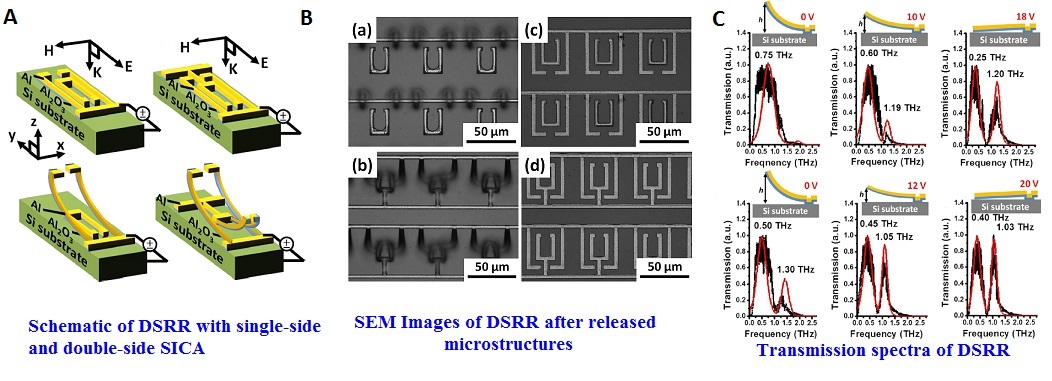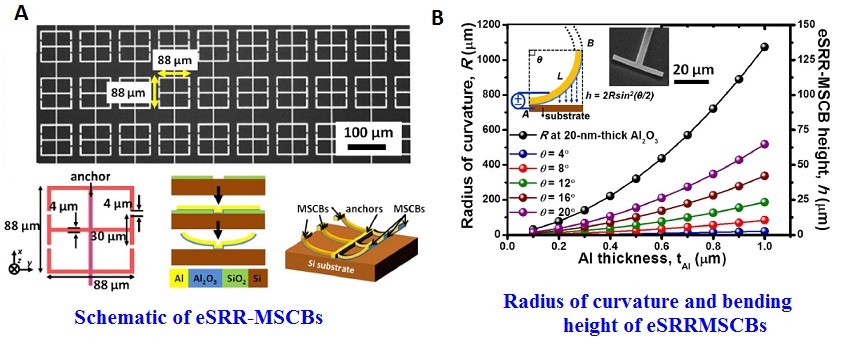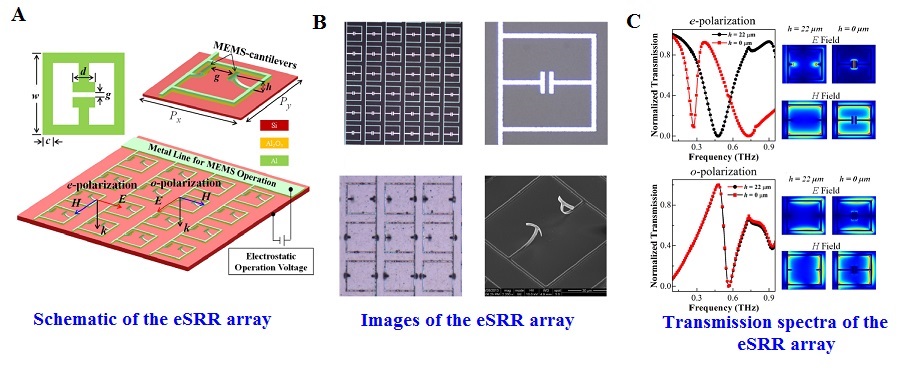Metamaterials have attracted intense interest for advanced applications in wide areas. Recent works on metamaterials have been extended to the terahertz (THz) frequency range, which result in new potential applications. Tunable THz metamaterials have also received significant attention because of their applications in optical communications, sensing and spectroscopy. Various methods have been proposed and demonstrated to tune the resonant frequency of a metamaterial,. Among these methods, geometrically changing the metamaterial unit cells by using microelectromechanical (MEMS) actuators or changing the refractive index of the metamaterial using liquid crystals are expected for more drastic change of THz transmission performance. In the case of MEMS-based tunable metamaterial, most of the previous works were focused on the planar types, while rare works were reported because of the challenge on fabrication processes for making three dimensional (3D) SRRs.
Currently, we are focusing on MEMS-compatible metamaterial structures adopting metal stress driven assembly strategy being investigated for tunable THz filter. It employs flexing MEMS-cantilevers for tuning the resonance frequency of a split-ring resonator (SRR). The MEMS-cantilevers used to tune the metamaterial are actuated by applying DC voltage between the chained SRR patterns and silicon substrate. The transmission spectra of the SRR arrays at different stages, i.e., different bending angles are measured by terahertz time domain spectroscopy (THz-TDS) in the transmission mode. The transmission spectra and field patterns corresponding to each resonance modes are also calculated by the finite-difference time-domain (FDTD) method.
The negative refractive index of Metamaterials in the THz range is attracting a lot of interest, but the broad-band tunability with optimal resonance transmittance still remains a challenge. Metamaterials employing liquid crystals as the surrounding medium can take advantage of their large birefringence property, which can cause shifts in the resonant frequency upon application of electric or magnetic field. This research fabricates a THz metamaterial device, where split ring resonator (SRR) array is deposited on a liquid crystal cell which is formed by two inward-facing indium tin oxide (ITO)-coated plastic substrates. The ability to vary the refractive index of the liquid crystal with the applied voltage helps enhance the resonance of the SRR array.
In this work, we have two ITO-coated polyester (PET) substrates filled with E7 liquid crystals with an Aluminium SRR array deposited on the top PET substrate using lift-off process. Our study uses external voltage to modify the permittivity of the liquid crystals, and the ITO coating of the PET substrate enhances voltage biasing owing to its high conductivity besides its high refractive index in the THz regime. The resonance enhancement in the result was from the high refractive index difference between these two materials in the liquid crystals/ITO interface. Our study proved that increase in the bias voltage increased the Reflectance of the SRR array and the resulting high intensity reflected waves coupled with the surfaceplasmon- polarition-like mode thereby increasing the resonance of the device, making it resemble an intensity-switchable band-stop filter in THz regime. We also studied the role of the ITO plates in the structure and we were able to prove that the high refractive index difference between the Liquid Crystal and the ITO plate contributed to the resonance enhancement. Having explored the effect of varying external voltage on the permittivity of the liquid crystal, and eventually the resonance of the SRR array, we have demonstrated a slightly modified design with the SRR array on the ITO film of the top PET substrate which makes the liquid crystal the surrounding media for the SRR.This setup showed the increase in the resonant transmittance with decreasing crystal permittivity. Integrating the above two designs with a double-side ITO-coated PET substrate showed a wide range resonance spectrum exhibiting the same resonant transmittance featuring many advantages like easy fabrication, low cost, free polarization and broad applications.

Selected Publications:
1.Zhen Liu, Chia-Yi Huang, Hongwei Liu, Xinhai Zhang and and Chengkuo Lee, Resonance enhancement of terahertz metamaterials by liquid crystals/indium tin oxide interfaces, Optics Express, vol. 21, no. 5, pp. 6519-6525, 2013. [PDF] [DOI]
Reconfigurable MMs have attracted usage in various applications such as sensors, switches and filters owing to their tunability by various fabrication and design technologies. This research demonstrates a three dimensional THz out of plane metamaterial (MM) filter that uses reconfigurable electric split-ring resonators (eSRR). This is accomplished by making planar arrays of eSRR with movable stress curved beams (eSRR-MSCBs) which are actuated out-of-plane by electrostatic force. MEMS technology offers a better realization of three-dimensional (3D) movable micromechanical devices, thus providing an ideal way to reconfigure the MM unit cells thereby allowing us to manipulate its refractive index properties.
In the first design, we have established a 3D movable THz MM filter using electric split-ring resonators with movable stress-curved beams (eSRR-MSCBs) that allows change in the in-plane gap between the unit and also the air gap between the metal and the substrate facilitating fine tuning. A terahertz time domain spectroscopy analysis was employed for the optical characterization of the fabricated 3D movable MMs when the gap between the eSRR-MSCBs and the substrate changes and a tuning range of 0.22 and 0.13 THz was achieved for varying DC bias. The results show that the eSRR-MSCBs possess blue-shifting capabilities promising applications in polarization control of light.

In another design, a MEMS based THz filter using released double split-ring resonator (DSRR) structures in three dimensional configurations was realized where the bending degree of the DSRRs can be adjusted using electrostatic force. Residual stress causes upward bending of the SRR structures and when released, they can be deflected towards the Silicon substrate with a varying DC bias and these released SRR cantilevers are called stress-induced curved actuators (SICAs) It was observed that a tunable metamaterial structure using stress induced cantilevers under electrostatic actuation scheme can be used as a DSRR THz filter of large frequency tuning range and high Q-factor. The experimental results show a tuning range of resonant peak of 0.50THz for DSRR with single-side SICA and 0.27 THz with double-side SICA which shows attractive features for potential applications in sensors and THz
Circuits, for these DSRR structures.

Selected Publications:
Employing deformable MEMs based curved cantilevers for tuning the resonance frequency of the electric split-ring resonators; we are able to attain terahertz frequency tunability with polarization-sensitivity. Recently, the Polarization dependent transmission properties of metamaterials in terms of anisotropic and bi-anisotropic effects have been investigated for various devices and we have explored this property of MMs for the THz range. In this design, we report the polarization sensitive data of the eSRR metamaterial structure using MEMS based single-fixed-end curved cantilever beams to achieve tunable behavior in the THz range. We have connected the individual eSRR unit cells are electrically using conducting metal line in order to electrically connect the entire array of eSRR unit cells forming a two dimensional (2D) eSRR array to allow electrostatic actuation with DC bias. Difference in the characteristics between e- and o-polarized incidences of the transmission spectra was found to be a function of cantilever beam positions. Results show that the reconfiguration of cantilever beams of the eSRRs is signified by a strong modification of the transmission spectra with a considerable tuning range of 0.21 THz for the e-polarization, whereas the transmission spectra for the o-polarization remain practically unchanged, which are critical to the development of polarization sensitive and insensitive THz polarimetric devices.

Selected Publications:
-
Fusheng Ma, You Qian, Yu-Sheng Lin, Hongwei Liu, Xinhai Zhang, Zhen Liu, Julius Ming-Lin Tsai and Chengkuo Lee, Polarization-sensitive microelectromechanical systems based tunable terahertz metamaterials using three dimensional electric split-ring resonator arrays, Appl. Phys. Lett., vol. 102, no. 16, 161912, 2013. [PDF] [DOI]
<<< Back to Research Areas
